change wheel FORD ECOSPORT 2022 Warranty Guide
[x] Cancel search | Manufacturer: FORD, Model Year: 2022, Model line: ECOSPORT, Model: FORD ECOSPORT 2022Pages: 73, PDF Size: 3.06 MB
Page 30 of 73
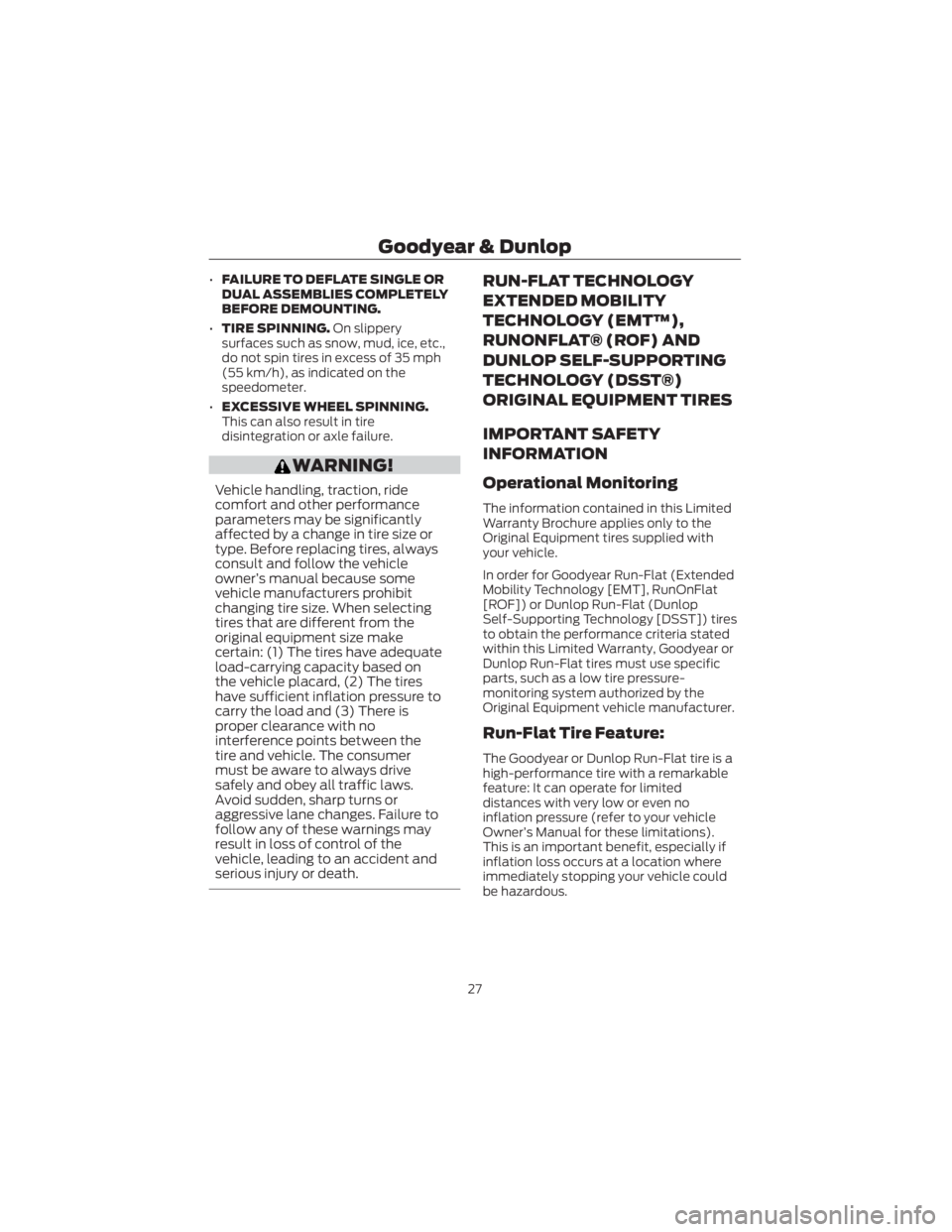
•FAILURE TO DEFLATE SINGLE OR
DUAL ASSEMBLIES COMPLETELY
BEFORE DEMOUNTING.
• TIRE SPINNING. On slippery
surfaces such as snow, mud, ice, etc.,
do not spin tires in excess of 35 mph
(55 km/h), as indicated on the
speedometer.
• EXCESSIVE WHEEL SPINNING.
This can also result in tire
disintegration or axle failure.
WARNING!
Vehicle handling, traction, ride
comfort and other performance
parameters may be significantly
affected by a change in tire size or
type. Before replacing tires, always
consult and follow the vehicle
owner’s manual because some
vehicle manufacturers prohibit
changing tire size. When selecting
tires that are different from the
original equipment size make
certain: (1) The tires have adequate
load-carrying capacity based on
the vehicle placard, (2) The tires
have sufficient inflation pressure to
carry the load and (3) There is
proper clearance with no
interference points between the
tire and vehicle. The consumer
must be aware to always drive
safely and obey all traffic laws.
Avoid sudden, sharp turns or
aggressive lane changes. Failure to
follow any of these warnings may
result in loss of control of the
vehicle, leading to an accident and
serious injury or death.
RUN-FLAT TECHNOLOGY
EXTENDED MOBILITY
TECHNOLOGY (EMT™),
RUNONFLAT® (ROF) AND
DUNLOP SELF-SUPPORTING
TECHNOLOGY (DSST®)
ORIGINAL EQUIPMENT TIRES
IMPORTANT SAFETY
INFORMATION
Operational Monitoring
The information contained in this Limited
Warranty Brochure applies only to the
Original Equipment tires supplied with
your vehicle.
In order for Goodyear Run-Flat (Extended
Mobility Technology [EMT], RunOnFlat
[ROF]) or Dunlop Run-Flat (Dunlop
Self-Supporting Technology [DSST]) tires
to obtain the performance criteria stated
within this Limited Warranty, Goodyear or
Dunlop Run-Flat tires must use specific
parts, such as a low tire pressure-
monitoring system authorized by the
Original Equipment vehicle manufacturer.
Run-Flat Tire Feature:
The Goodyear or Dunlop Run-Flat tire is a
high-performance tire with a remarkable
feature: It can operate for limited
distances with very low or even no
inflation pressure (refer to your vehicle
Owner’s Manual for these limitations).
This is an important benefit, especially if
inflation loss occurs at a location where
immediately stopping your vehicle could
be hazardous.
Goodyear & Dunlop
27
Page 44 of 73
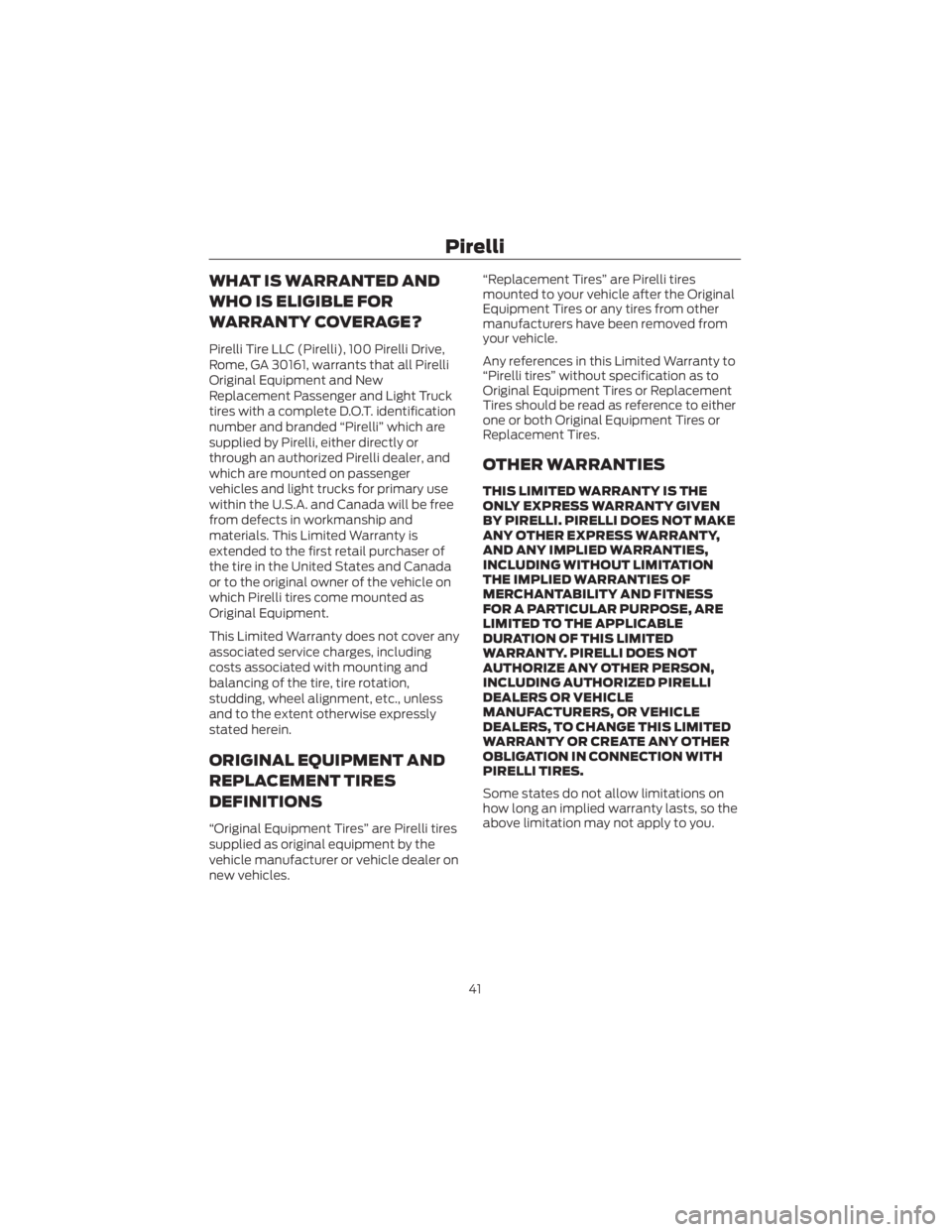
WHAT IS WARRANTED AND
WHO IS ELIGIBLE FOR
WARRANTY COVERAGE?
Pirelli Tire LLC (Pirelli), 100 Pirelli Drive,
Rome, GA 30161, warrants that all Pirelli
Original Equipment and New
Replacement Passenger and Light Truck
tires with a complete D.O.T. identification
number and branded “Pirelli” which are
supplied by Pirelli, either directly or
through an authorized Pirelli dealer, and
which are mounted on passenger
vehicles and light trucks for primary use
within the U.S.A. and Canada will be free
from defects in workmanship and
materials. This Limited Warranty is
extended to the first retail purchaser of
the tire in the United States and Canada
or to the original owner of the vehicle on
which Pirelli tires come mounted as
Original Equipment.
This Limited Warranty does not cover any
associated service charges, including
costs associated with mounting and
balancing of the tire, tire rotation,
studding, wheel alignment, etc., unless
and to the extent otherwise expressly
stated herein.
ORIGINAL EQUIPMENT AND
REPLACEMENT TIRES
DEFINITIONS
“Original Equipment Tires” are Pirelli tires
supplied as original equipment by the
vehicle manufacturer or vehicle dealer on
new vehicles.“Replacement Tires” are Pirelli tires
mounted to your vehicle after the Original
Equipment Tires or any tires from other
manufacturers have been removed from
your vehicle.
Any references in this Limited Warranty to
“Pirelli tires” without specification as to
Original Equipment Tires or Replacement
Tires should be read as reference to either
one or both Original Equipment Tires or
Replacement Tires.
OTHER WARRANTIES
THIS LIMITED WARRANTY IS THE
ONLY EXPRESS WARRANTY GIVEN
BY PIRELLI. PIRELLI DOES NOT MAKE
ANY OTHER EXPRESS WARRANTY,
AND ANY IMPLIED WARRANTIES,
INCLUDING WITHOUT LIMITATION
THE IMPLIED WARRANTIES OF
MERCHANTABILITY AND FITNESS
FOR A PARTICULAR PURPOSE, ARE
LIMITED TO THE APPLICABLE
DURATION OF THIS LIMITED
WARRANTY. PIRELLI DOES NOT
AUTHORIZE ANY OTHER PERSON,
INCLUDING AUTHORIZED PIRELLI
DEALERS OR VEHICLE
MANUFACTURERS, OR VEHICLE
DEALERS, TO CHANGE THIS LIMITED
WARRANTY OR CREATE ANY OTHER
OBLIGATION IN CONNECTION WITH
PIRELLI TIRES.
Some states do not allow limitations on
how long an implied warranty lasts, so the
above limitation may not apply to you.
Pirelli
41
Page 47 of 73
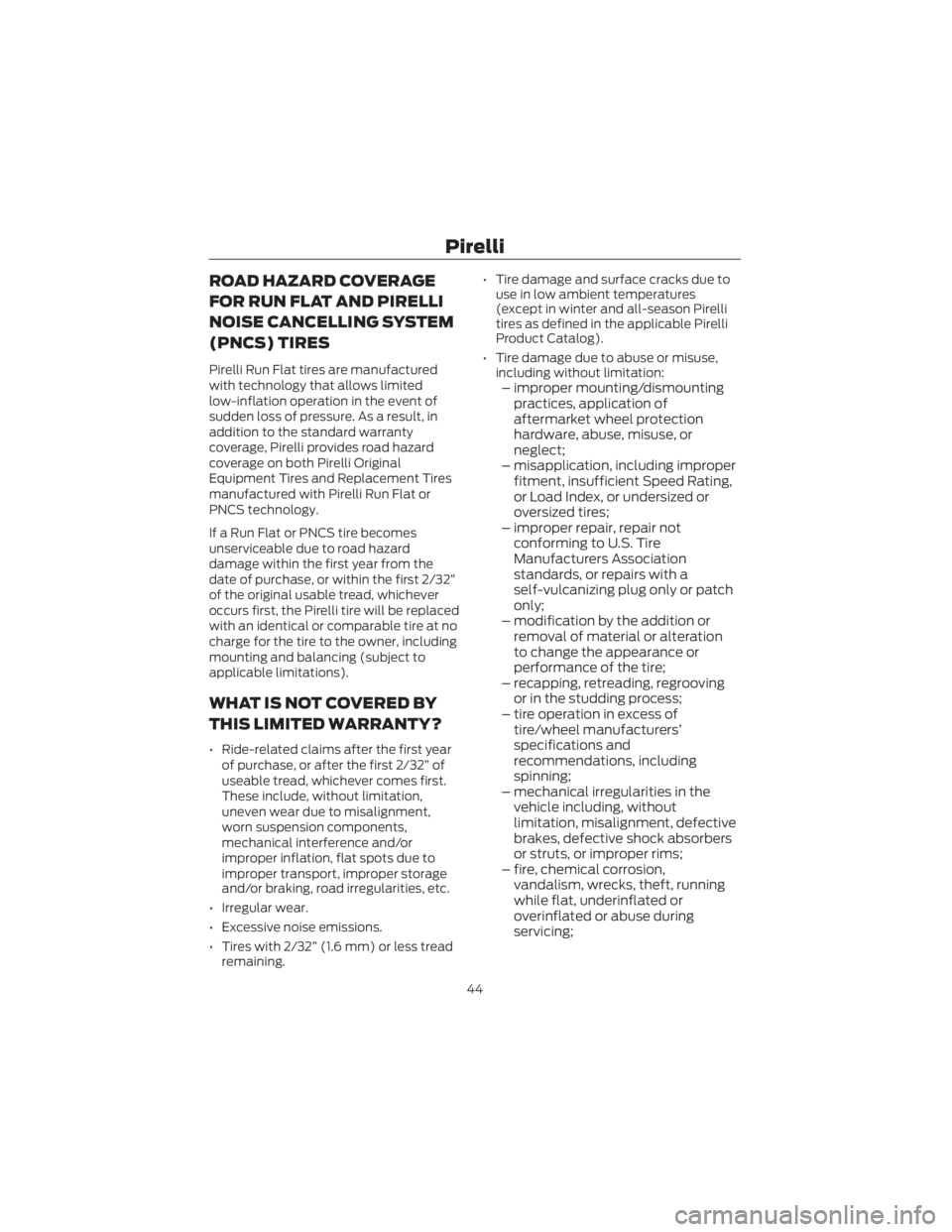
ROAD HAZARD COVERAGE
FOR RUN FLAT AND PIRELLI
NOISE CANCELLING SYSTEM
(PNCS) TIRES
Pirelli Run Flat tires are manufactured
with technology that allows limited
low-inflation operation in the event of
sudden loss of pressure. As a result, in
addition to the standard warranty
coverage, Pirelli provides road hazard
coverage on both Pirelli Original
Equipment Tires and Replacement Tires
manufactured with Pirelli Run Flat or
PNCS technology.
If a Run Flat or PNCS tire becomes
unserviceable due to road hazard
damage within the first year from the
date of purchase, or within the first 2/32”
of the original usable tread, whichever
occurs first, the Pirelli tire will be replaced
with an identical or comparable tire at no
charge for the tire to the owner, including
mounting and balancing (subject to
applicable limitations).
WHAT IS NOT COVERED BY
THIS LIMITED WARRANTY?
• Ride-related claims after the first yearof purchase, or after the first 2/32” of
useable tread, whichever comes first.
These include, without limitation,
uneven wear due to misalignment,
worn suspension components,
mechanical interference and/or
improper inflation, flat spots due to
improper transport, improper storage
and/or braking, road irregularities, etc.
• Irregular wear.
• Excessive noise emissions.
• Tires with 2/32” (1.6 mm) or less tread remaining. • Tire damage and surface cracks due to
use in low ambient temperatures
(except in winter and all-season Pirelli
tires as defined in the applicable Pirelli
Product Catalog).
• Tire damage due to abuse or misuse, including without limitation:
– improper mounting/dismountingpractices, application of
aftermarket wheel protection
hardware, abuse, misuse, or
neglect;
– misapplication, including improper fitment, insufficient Speed Rating,
or Load Index, or undersized or
oversized tires;
– improper repair, repair not conforming to U.S. Tire
Manufacturers Association
standards, or repairs with a
self-vulcanizing plug only or patch
only;
– modification by the addition or removal of material or alteration
to change the appearance or
performance of the tire;
– recapping, retreading, regrooving or in the studding process;
– tire operation in excess of tire/wheel manufacturers’
specifications and
recommendations, including
spinning;
– mechanical irregularities in the vehicle including, without
limitation, misalignment, defective
brakes, defective shock absorbers
or struts, or improper rims;
– fire, chemical corrosion, vandalism, wrecks, theft, running
while flat, underinflated or
overinflated or abuse during
servicing;
Pirelli
44
Page 55 of 73
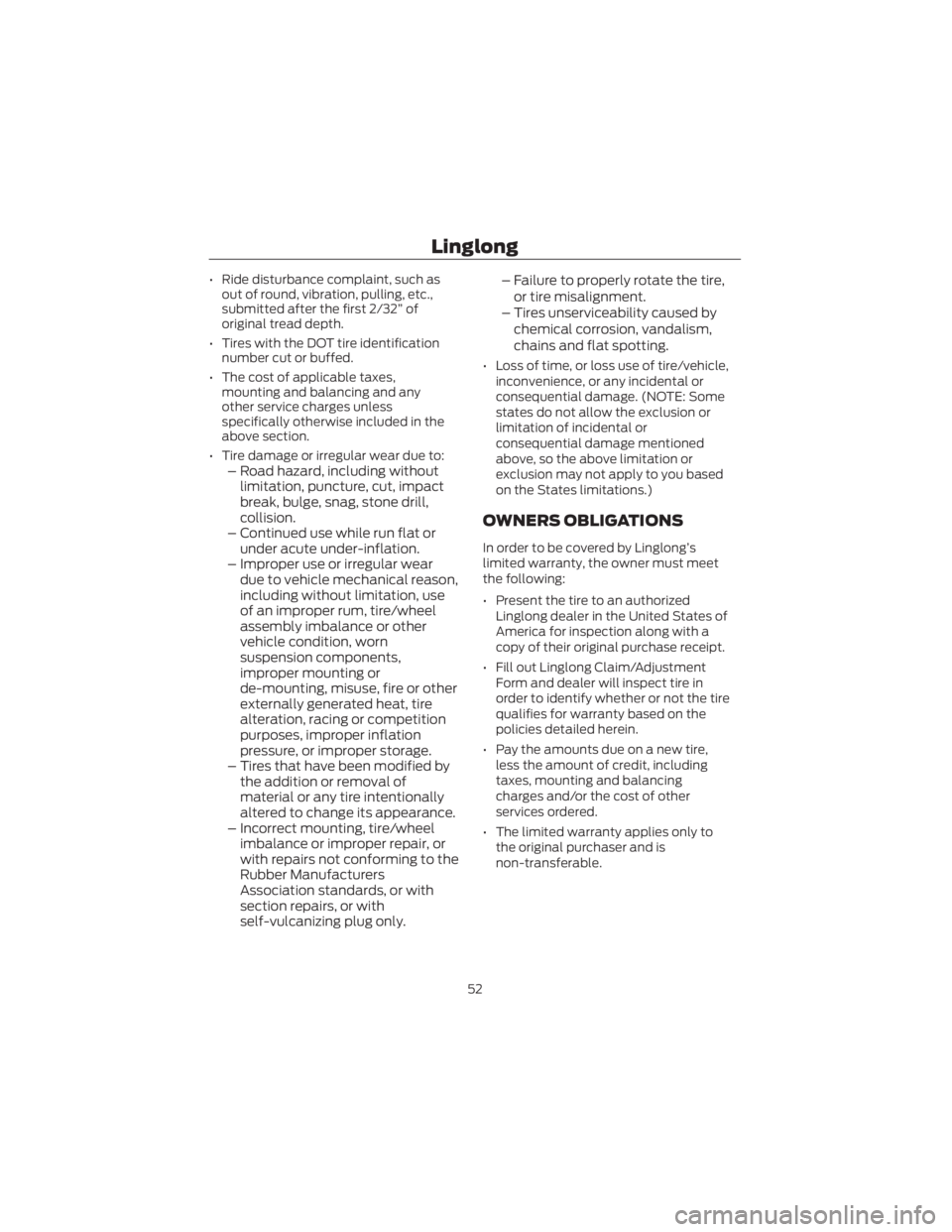
• Ride disturbance complaint, such asout of round, vibration, pulling, etc.,
submitted after the first 2/32” of
original tread depth.
• Tires with the DOT tire identification number cut or buffed.
• The cost of applicable taxes, mounting and balancing and any
other service charges unless
specifically otherwise included in the
above section.
• Tire damage or irregular wear due to:
– Road hazard, including without limitation, puncture, cut, impact
break, bulge, snag, stone drill,
collision.
– Continued use while run flat or under acute under-inflation.
– Improper use or irregular wear due to vehicle mechanical reason,
including without limitation, use
of an improper rum, tire/wheel
assembly imbalance or other
vehicle condition, worn
suspension components,
improper mounting or
de-mounting, misuse, fire or other
externally generated heat, tire
alteration, racing or competition
purposes, improper inflation
pressure, or improper storage.
– Tires that have been modified by the addition or removal of
material or any tire intentionally
altered to change its appearance.
– Incorrect mounting, tire/wheel imbalance or improper repair, or
with repairs not conforming to the
Rubber Manufacturers
Association standards, or with
section repairs, or with
self-vulcanizing plug only. – Failure to properly rotate the tire,
or tire misalignment.
– Tires unserviceability caused by chemical corrosion, vandalism,
chains and flat spotting.
• Loss of time, or loss use of tire/vehicle,
inconvenience, or any incidental or
consequential damage. (NOTE: Some
states do not allow the exclusion or
limitation of incidental or
consequential damage mentioned
above, so the above limitation or
exclusion may not apply to you based
on the States limitations.)
OWNERS OBLIGATIONS
In order to be covered by Linglong’s
limited warranty, the owner must meet
the following:
• Present the tire to an authorizedLinglong dealer in the United States of
America for inspection along with a
copy of their original purchase receipt.
• Fill out Linglong Claim/Adjustment Form and dealer will inspect tire in
order to identify whether or not the tire
qualifies for warranty based on the
policies detailed herein.
• Pay the amounts due on a new tire, less the amount of credit, including
taxes, mounting and balancing
charges and/or the cost of other
services ordered.
• The limited warranty applies only to the original purchaser and is
non-transferable.
Linglong
52
Page 66 of 73
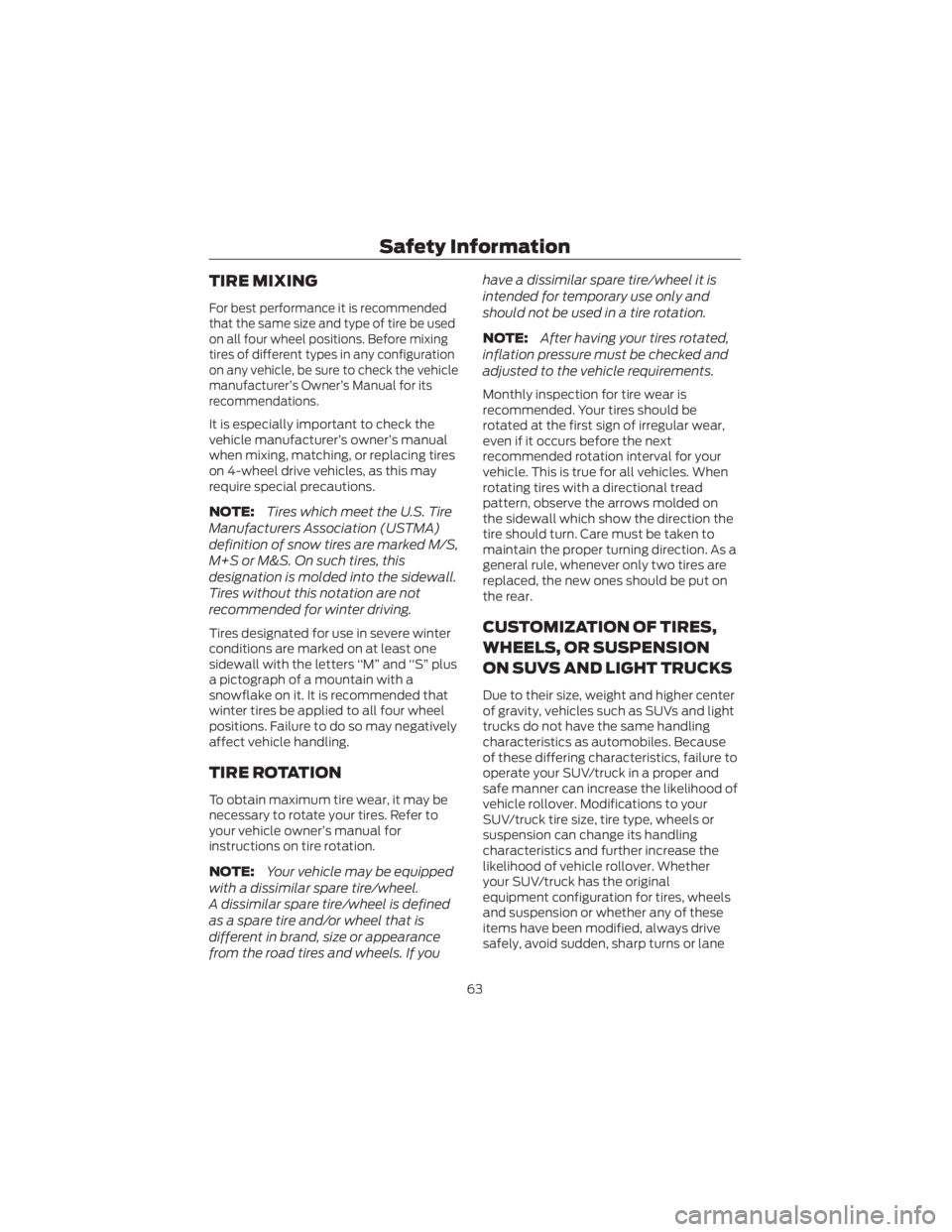
TIRE MIXING
For best performance it is recommended
that the same size and type of tire be used
on all four wheel positions. Before mixing
tires of different types in any configuration
on any vehicle, be sure to check the vehicle
manufacturer’s Owner’s Manual for its
recommendations.
It is especially important to check the
vehicle manufacturer’s owner’s manual
when mixing, matching, or replacing tires
on 4-wheel drive vehicles, as this may
require special precautions.
NOTE:Tires which meet the U.S. Tire
Manufacturers Association (USTMA)
definition of snow tires are marked M/S,
M+S or M&S. On such tires, this
designation is molded into the sidewall.
Tires without this notation are not
recommended for winter driving.
Tires designated for use in severe winter
conditions are marked on at least one
sidewall with the letters ‘‘M” and ‘‘S” plus
a pictograph of a mountain with a
snowflake on it. It is recommended that
winter tires be applied to all four wheel
positions. Failure to do so may negatively
affect vehicle handling.
TIRE ROTATION
To obtain maximum tire wear, it may be
necessary to rotate your tires. Refer to
your vehicle owner’s manual for
instructions on tire rotation.
NOTE: Your vehicle may be equipped
with a dissimilar spare tire/wheel.
A dissimilar spare tire/wheel is defined
as a spare tire and/or wheel that is
different in brand, size or appearance
from the road tires and wheels. If you have a dissimilar spare tire/wheel it is
intended for temporary use only and
should not be used in a tire rotation.
NOTE:
After having your tires rotated,
inflation pressure must be checked and
adjusted to the vehicle requirements.
Monthly inspection for tire wear is
recommended. Your tires should be
rotated at the first sign of irregular wear,
even if it occurs before the next
recommended rotation interval for your
vehicle. This is true for all vehicles. When
rotating tires with a directional tread
pattern, observe the arrows molded on
the sidewall which show the direction the
tire should turn. Care must be taken to
maintain the proper turning direction. As a
general rule, whenever only two tires are
replaced, the new ones should be put on
the rear.
CUSTOMIZATION OF TIRES,
WHEELS, OR SUSPENSION
ON SUVS AND LIGHT TRUCKS
Due to their size, weight and higher center
of gravity, vehicles such as SUVs and light
trucks do not have the same handling
characteristics as automobiles. Because
of these differing characteristics, failure to
operate your SUV/truck in a proper and
safe manner can increase the likelihood of
vehicle rollover. Modifications to your
SUV/truck tire size, tire type, wheels or
suspension can change its handling
characteristics and further increase the
likelihood of vehicle rollover. Whether
your SUV/truck has the original
equipment configuration for tires, wheels
and suspension or whether any of these
items have been modified, always drive
safely, avoid sudden, sharp turns or lane
Safety Information
63
Page 67 of 73
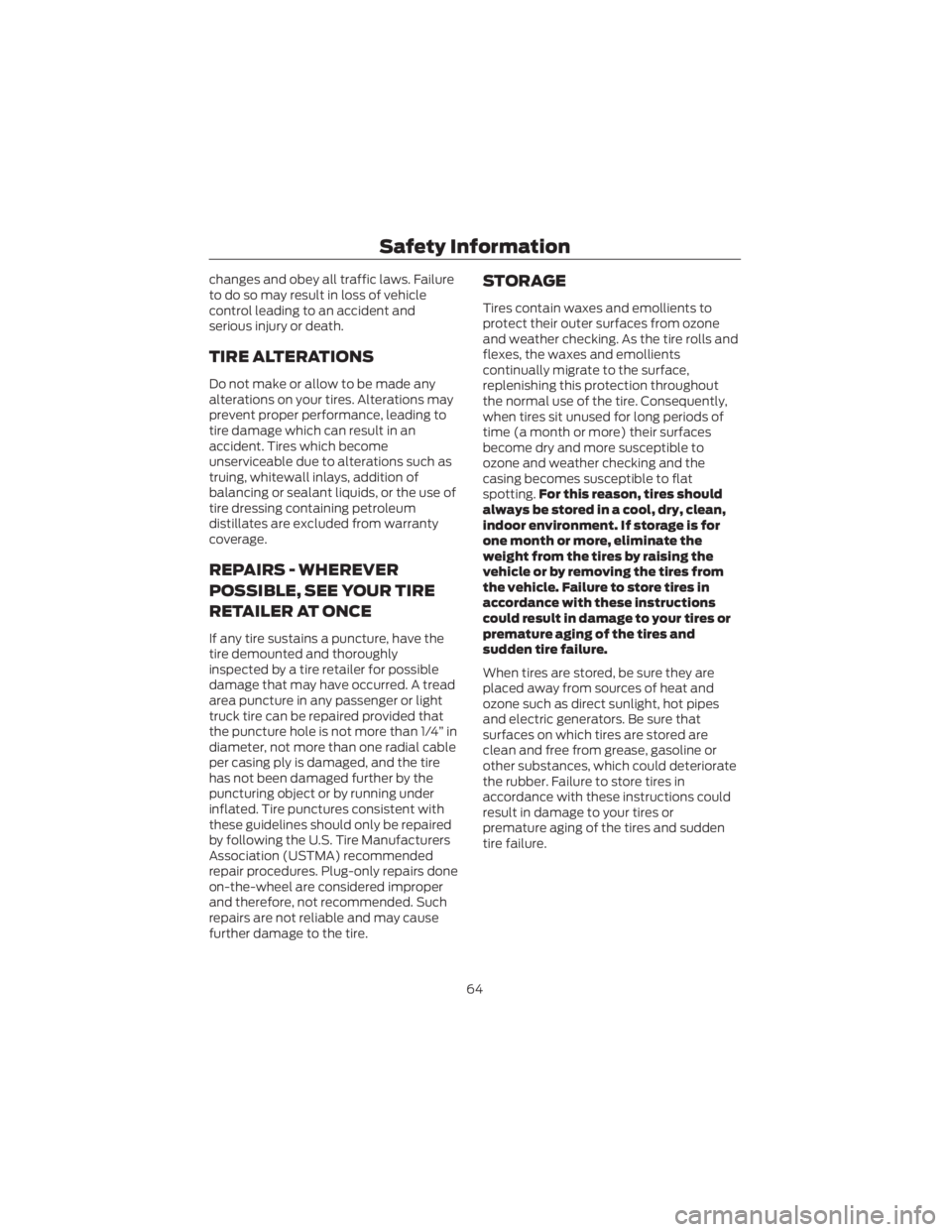
changes and obey all traffic laws. Failure
to do so may result in loss of vehicle
control leading to an accident and
serious injury or death.
TIRE ALTERATIONS
Do not make or allow to be made any
alterations on your tires. Alterations may
prevent proper performance, leading to
tire damage which can result in an
accident. Tires which become
unserviceable due to alterations such as
truing, whitewall inlays, addition of
balancing or sealant liquids, or the use of
tire dressing containing petroleum
distillates are excluded from warranty
coverage.
REPAIRS - WHEREVER
POSSIBLE, SEE YOUR TIRE
RETAILER AT ONCE
If any tire sustains a puncture, have the
tire demounted and thoroughly
inspected by a tire retailer for possible
damage that may have occurred. A tread
area puncture in any passenger or light
truck tire can be repaired provided that
the puncture hole is not more than 1/4” in
diameter, not more than one radial cable
per casing ply is damaged, and the tire
has not been damaged further by the
puncturing object or by running under
inflated. Tire punctures consistent with
these guidelines should only be repaired
by following the U.S. Tire Manufacturers
Association (USTMA) recommended
repair procedures. Plug-only repairs done
on-the-wheel are considered improper
and therefore, not recommended. Such
repairs are not reliable and may cause
further damage to the tire.
STORAGE
Tires contain waxes and emollients to
protect their outer surfaces from ozone
and weather checking. As the tire rolls and
flexes, the waxes and emollients
continually migrate to the surface,
replenishing this protection throughout
the normal use of the tire. Consequently,
when tires sit unused for long periods of
time (a month or more) their surfaces
become dry and more susceptible to
ozone and weather checking and the
casing becomes susceptible to flat
spotting.For this reason, tires should
always be stored in a cool, dry, clean,
indoor environment. If storage is for
one month or more, eliminate the
weight from the tires by raising the
vehicle or by removing the tires from
the vehicle. Failure to store tires in
accordance with these instructions
could result in damage to your tires or
premature aging of the tires and
sudden tire failure.
When tires are stored, be sure they are
placed away from sources of heat and
ozone such as direct sunlight, hot pipes
and electric generators. Be sure that
surfaces on which tires are stored are
clean and free from grease, gasoline or
other substances, which could deteriorate
the rubber. Failure to store tires in
accordance with these instructions could
result in damage to your tires or
premature aging of the tires and sudden
tire failure.
Safety Information
64